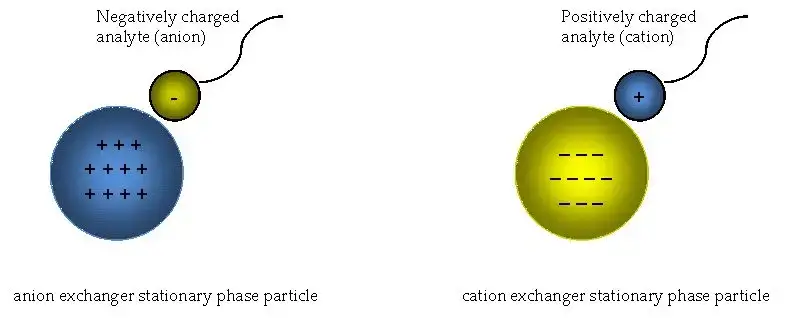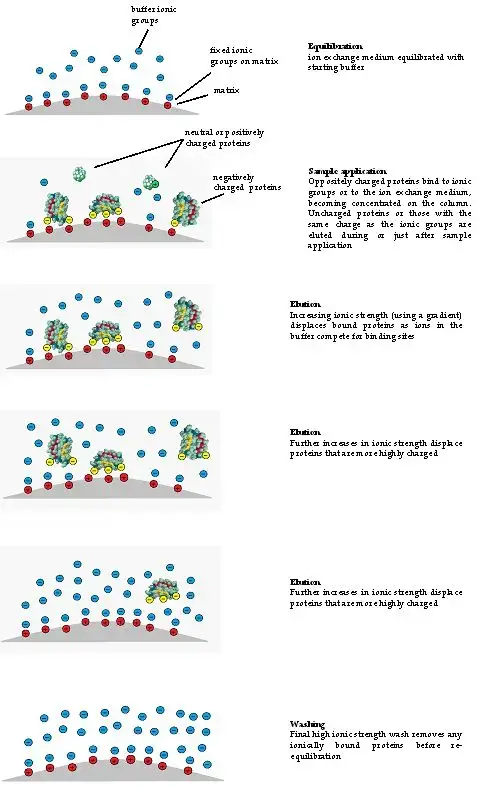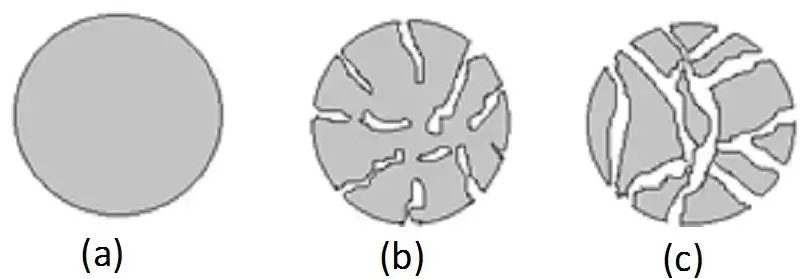Ion exchange chromatography (IEC) is a chromatographic technique that allows for the separation of ions and polar molecules based on their charge. It utilizes a stationary phase composed of an insoluble matrix with covalently bonded charged groups. These charged groups can attract and bind ions of the opposite charge present in the mobile phase, which is typically an aqueous solution.
The basic principle of IEC involves the reversible exchange of ions between the ions in the sample and the ions attached to the stationary phase. The interaction strength and thus the retention time of each ion on the column depend on various factors, including the charge and size of the ions, the strength of the ionic interactions, and the conditions of the mobile phase (such as its pH and ionic strength).
IEC is widely used in both analytical and preparative applications, including the purification of proteins, peptides, nucleic acids, and other charged biomolecules, as well as the separation of inorganic ions for water treatment, environmental analysis, and other industrial processes. The technique is known for its high specificity, resolution, and capacity to handle complex mixtures, making it a valuable tool in biochemistry, molecular biology, and analytical chemistry.
Ion exchange mechanism
The ion exchange mechanism in chromatography is a key process for separating charged molecules in a mixture based on their affinity to ion exchangers. This process involves several critical components and steps, outlined as follows:

- Stationary and Mobile Phases:
- Ion exchange chromatography consists of a stationary phase, typically an inert organic matrix with ionizable functional groups, and a mobile phase, usually an aqueous buffer system. The stationary phase carries fixed ions with displaceable counterions of the opposite charge.
- Counterions and Equilibrium:
- Ions in the sample that can exchange with the fixed ions on the stationary phase are referred to as counterions. This exchange occurs while maintaining an equilibrium between the mobile and stationary phases, facilitating the separation of ions.
- Types of Ion Exchangers:
- The stationary phase can feature various ionizable groups, including protons (H+), hydroxide groups (OH-), monoatomic ions (Na+, K+, Cl-), and polyatomic ions (SO42-, PO43-), among others. This versatility allows for the separation of a wide range of charged molecules.
- Cation and Anion Exchange:
- Separation occurs through the binding of analytes to the charged groups on the stationary phase. Cations are separated on cation-exchange resins, while anions are processed on anion-exchange resins, based on their net surface charges.
- pH Dependence and Elution:
- The net surface charge of molecules with ionizable groups is highly pH-dependent. Adjusting the mobile phase’s pH can influence the binding affinity of proteins to the matrix, facilitating their elution. Increasing the concentration of similarly charged species in the mobile phase can also result in the displacement and elution of bound proteins.
- Complex Mixture Separation:
- Ion exchange chromatography can separate and quantify complex mixtures of anions or cations efficiently. Modern ion exchange materials, combined with flow-through detection, have enhanced the technique’s effectiveness, overcoming limitations such as slow flow rates and reduced separation efficiency.
- Adsorption and Desorption Dynamics:
- The adsorption of analytes to the stationary phase and their subsequent desorption by eluent ions is a continuous process that results in separation. This dynamic equilibrium is influenced by the properties of the stationary phase, the mobile phase constituents, and the solutes.

Ion exchange chromatography’s mechanism is based on the electrostatic interactions between the charged stationary phase and the ions in the sample, facilitated by the mobile phase. This technique is widely applied in the analysis of a broad range of ionic and polar analytes, including bioactive molecules, due to its high capacity, resolving power, and versatility.
Stationary phase of Ion Exchange Chromatography
The stationary phase in ion exchange chromatography is critical for the separation process, involving a matrix with charged functional groups that interact with charged analytes. Understanding the selection and properties of the stationary phase is essential for effective chromatographic separation. Here are key points regarding the stationary phase in ion exchange chromatography:

- Selection Criteria:
- Choosing the appropriate ion-exchange matrix is crucial and depends on factors like the ion exchanger’s charge, the sample’s properties, and the desired flow rate.
- Stationary Phase Composition:
- Consists of an inert matrix, typically an organic polymer, modified with ionizable functional groups (fixed ions) that carry displaceable counterions of the opposite charge.
- Types of Ion Exchangers:
- Cation exchangers possess negatively charged groups and exchange cations.
- Anion exchangers have positively charged groups and exchange anions.
- Matrix Properties:
- The matrix affects the chromatography’s physical and chemical stability, flow characteristics, and potential for nonspecific binding.
- Important attributes include general structure (fibrous or beaded), particle size, porosity, surface chemistry, and swelling characteristics.
- Porosity:
- Non-porous, microporous, and macroporous matrices are available, with porosity influencing surface area, binding capacity, and suitability for large molecule separation.
- Matrix Materials:
- Common materials include cellulose, dextran, agarose, polyacrylamide, and synthetic polymers like polystyrene-divinylbenzene, each with specific properties suitable for different separation needs.
- Functional Groups:
- The type and density of charged groups on the matrix dictate the specificity and strength of ion binding. Common groups include sulfonic acids for strong cation exchangers and quaternary amines for strong anion exchangers.
- Ion Exchange Capacity:
- Defined by the number of functional groups per unit weight or volume of the resin, influencing the total binding capacity for charged analytes.
- Flow Characteristics and Resolution:
- Particle size and uniformity impact the flow rates and chromatographic resolution, with smaller, uniform particles providing higher resolution.
- pH and Chemical Stability:
- The stability of the matrix across different pH values and in the presence of various chemicals is crucial for maintaining consistent performance and longevity of the stationary phase.

Mobile phase (Eluent)
In ion exchange chromatography, the mobile phase, or eluent, plays a critical role in facilitating the separation and purification of charged molecules. The composition and characteristics of the eluent are carefully chosen to optimize the separation process based on the specific requirements of the sample and the stationary phase. Here are the key aspects related to the mobile phase in ion exchange chromatography:
- Composition:
- The eluent typically consists of an aqueous solution of suitable salts or salt mixtures, often combined with a small percentage of an organic solvent to enhance solubility of ionic compounds.
- Common Eluents:
- Sodium chloride (NaCl) is a frequently used eluent due to its mild impact on protein structure and good solubility for most proteins. However, the effectiveness of NaCl and other salts can vary depending on the specific application.
- Buffer Systems:
- The eluent may also contain buffer systems to maintain a stable pH, which is crucial for the preservation of biomolecule integrity and the consistency of ion exchange interactions.
- Impact of Anions and Cations:
- The nature of anions and cations in the eluent can significantly affect retention times, peak widths, and overall chromatographic resolution, particularly with anion exchangers.
- Eluent pH:
- The pH of the eluent influences the ionization state of both the stationary phase functional groups and the analytes, affecting the selectivity and efficiency of the separation process.
- Competing Ions:
- The concentration of competing ions in the eluent determines their efficacy in displacing analyte ions from the stationary phase, thereby influencing the elution rate and separation quality.
- Flow Rate and Temperature:
- The eluent flow rate and temperature can impact the elution profile and efficiency of separation, with faster flow rates typically resulting in quicker elution and higher temperatures potentially improving chromatographic resolution.
- Degassing:
- It’s important to degas the eluent to prevent air bubbles, which can disrupt the eluent flow and affect the separation process, as well as to minimize changes in eluent composition due to dissolved gases like CO2.
- Equilibration:
- Prior to sample injection, the column must be equilibrated with the eluent to ensure that all ion exchange sites are occupied by the desired counter ions, setting the stage for consistent and reproducible ion exchange interactions.
- Elution Strategies:
- Isocratic elution uses a single buffer throughout the separation, while gradient elution involves changing the eluent composition, typically by varying ionic strength or pH, to elute bound analytes more effectively.
- Additives:
- Protective agents and other additives may be included in the eluent to stabilize and protect the analytes, preventing denaturation, aggregation, or degradation during the chromatographic process.
Buffer
In ion exchange chromatography, the buffer, also known as the eluent or mobile phase component, is crucial for maintaining a stable pH throughout the separation process. This stability is essential to ensure consistent charges on both the stationary phase and the analytes, which directly influences the separation efficiency. Here are key points regarding the role and selection of buffers in ion exchange chromatography:
- pH Control:
- Buffers are used to control and adjust the pH value of the mobile phase, ensuring that the ion exchange process is consistent and predictable by maintaining a constant pH.
- Buffer Composition:
- Common buffers include aqueous solutions of salts or salt mixtures, sometimes combined with a small percentage of organic solvents. Sodium chloride (NaCl) is a popular choice due to its mild effect on protein structures.
- Buffer Selection Criteria:
- The choice of buffer is influenced by several factors, including its charge, strength, pH, and compatibility with the stationary phase and sample components.
- Buffer Properties:
- Effective buffers have high buffering capacity at the desired working pH, high solubility, purity, and cost-effectiveness. They should not significantly contribute to conductivity and should not interact undesirably with the stationary phase or analytes.
- Buffer Concentration:
- Typical buffer concentrations range from 10 to 50 mM, optimized to provide sufficient buffering capacity without overly contributing to the mobile phase’s ionic strength.
- pKa and pH Range:
- The pKa of the buffer should be close to the desired pH value, ideally within ±0.5 pH units, to ensure effective buffering. The working pH range for ion exchange chromatography typically spans from slightly acidic to slightly alkaline conditions (pH 6.0-8.5).
- Buffer-Ion Exchanger Interaction:
- Buffers should not bind to the ion exchanger or act as eluting ions, which could interfere with the ion exchange process. Anionic buffers like phosphate or MOPS are recommended for cation exchange chromatography, while cationic buffers such as ethanolamine, Tris, and Tricine are suitable for anion exchange chromatography.
- Temperature Dependence:
- The pKa and buffering capacity of buffers can be temperature-dependent. Experiments performed at different temperatures (e.g., room temperature vs. cold room) can significantly impact buffer efficacy.
- Buffer Additives:
- Additives may be included in the buffer to stabilize proteins, prevent precipitation, or protect against enzymatic degradation. These additives should be carefully selected to avoid adverse interactions with the ion exchange process.
Detection
In ion exchange chromatography, the detection of eluted analytes is a crucial step for identifying and quantifying the components of a sample. Various detection methods are employed, each with its specific applications and advantages:
- Conductivity Detection:
- The most commonly used detector in ion exchange chromatography is the conductivity detector, which measures the conductance of solute ions in the eluent.
- Conductivity detection is highly sensitive, especially when measuring solutes with significant conductance in an eluent with low background conductance. To achieve optimal sensitivity, dilute eluents are recommended, and the ion exchange capacity of the column should be kept low.
- UV Detection:
- UV detectors are also widely used in ion exchange chromatography, particularly for detecting anions that absorb in the UV spectral region.
- For anions with little or no UV absorbance, a strongly absorbing eluent anion can be selected to facilitate spectrophotometric detection.
- Choice of Eluent Anion (E-):
- The selection of the eluent anion is critical, especially when UV detection is employed. Anions with a benzene ring, for example, are suitable due to their strong absorbance in the UV range.
- The eluent anion must be compatible with the chosen detection method. For conductivity detection, the eluent anion should either have significantly lower conductivity than the sample ions or be convertible to a non-ionic form by a chemical suppression system.
- Data Collection and Analysis:
- Modern ion exchange chromatography systems typically store results digitally, with computers recording retention times and peak areas.
- Retention times are crucial for identifying unknown peaks by comparison with known standards, while peak areas are compared against standards of known concentration to calculate the analyte concentration.
- Compatibility with Detection Method:
- When selecting an eluent anion for spectrophotometric detection, its ability to absorb strongly in the UV or visible spectral region is often a key consideration.
- The concentration of the eluent anion in the eluent depends on the properties of the ion exchanger and the types of anions being separated.
References
- Bahadir, O. (2013). Ion-Exchange Chromatography and Its Applications. InTech. doi: 10.5772/55744
- Text Highlighting: Select any text in the post content to highlight it
- Text Annotation: Select text and add comments with annotations
- Comment Management: Edit or delete your own comments
- Highlight Management: Remove your own highlights
How to use: Simply select any text in the post content above, and you'll see annotation options. Login here or create an account to get started.